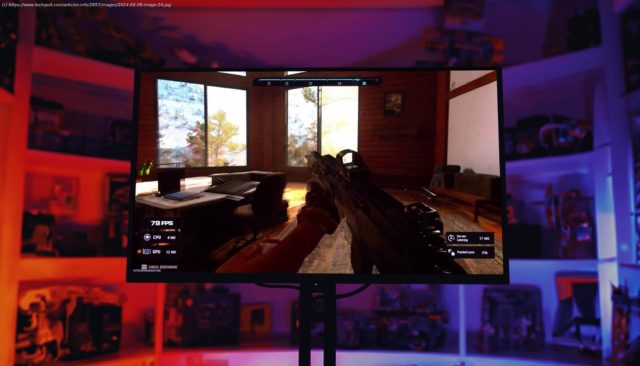Stop! If you’re thinking of upgrading your gaming PC, don’t buy that overpriced graphics card or even a new CPU. Instead, invest in a new monitor which.
Stop! If you’re thinking of upgrading your gaming PC setup, don’t buy that overpriced graphics card or even a new CPU. Buy a nice new gaming monitor instead, and we’ll prove to you why, for most people, upgrading your monitor will provide a larger improvement to your gaming experience than a faster GPU.
This comes down to four main factors:
Many gamers are still playing games on relatively low-end displays, and while some have been slowly upgrading to newer displays over the years, we still hear from people today who are using a 1080p 60Hz monitor, a class of product we no longer recommend.
Case in point, according to the Steam Hardware Survey, 58% of gamers are still using a 1080p display. Just 19% are on 1440p, and only 4% on 4K. While this may not entirely represent all PC gamers worldwide, it is a significant survey with a large sample size.
Depending on what monitor you have today, there are many areas that can be improved through a monitor upgrade. The primary ones are resolution, refresh rate, response time speed, colors, and HDR – all of which have a direct impact on gaming. The older your monitor is, the more areas will be upgraded.
Resolution is a big one. 1440p monitors simply look far better than 1080p monitors in terms of sharpness and image quality. 4K is another step up, less so at 27 inches, but significantly so at larger panel sizes like 32 inches. And not only do higher resolution monitors look better in general, but various graphical effects in games also work better at higher resolutions.
Upscaling is one key example; we’ve mentioned many times how DLSS and FSR simply look better and have less ghosting and other visual artifacts when the final output resolution is higher, ideally 4K for the least issues. Higher resolution monitors enable sharper visuals and fewer artifacts in motion due to modern games’ heavy use of temporal rendering.
Some people still believe that 60Hz is sufficient for gaming, and those people are wrong. Higher refresh rate monitors deliver a much better experience, with far superior smoothness and lower input latency, making games feel better and more responsive to play. Coupled with this is that all high refresh rate monitors on the market today support variable refresh rates, which deliver a smooth presentation no matter the in-game frame rate and minimize issues like tearing and Vsync stutter.
A moderate refresh rate like 144Hz is such a massive upgrade over 60Hz that it’s essential for anyone on a 60Hz monitor to make buying a 144Hz monitor the highest priority. There’s no point in upgrading your graphics card to play games at higher frame rates, resolutions, and quality settings if you’re bottlenecking it with either a low resolution or a low refresh rate. This is especially true for multiplayer games, where higher refresh rates and the corresponding lower latency literally make the game easier – and more enjoyable.
Of course, there’s a bit of a chicken-and-egg situation here. You can’t benefit from a monitor’s higher resolution and refresh rate if you don’t have the PC horsepower to run games at higher resolutions and refresh rates. But the great thing about monitors, and modern games, is you don’t need to utilize all the new capabilities at once. Most monitors have great longevity and genuinely provide future-proofing.
For example, if you have a 1080p 60Hz monitor and upgrade to 1440p 144Hz, you don’t have to immediately go from playing games at 1080p 60 FPS to 1440p 144 FPS. You could start with a bump in resolution, then later increase the frame rate through setting tweaks or hardware upgrades. Or do the reverse and prioritize refresh rate.
Many graphics cards are actually more capable of handling these scenarios than you might think, as even mainstream products like the RTX 3060 are sufficient for more than 1080p 60 FPS in most modern games using ultra settings without upscaling.
Even if you don’t have an especially powerful GPU, new monitors can provide a visual enhancement without any improvement to resolution or refresh rate. Faster response times, for example, literally make the image clearer and easier to see in motion with fewer artifacts. And there’s been significant gains in this area over just the last four to five years.
Take the Pixio PX277 Prime, a $330 1440p 165Hz IPS gaming monitor from four years ago. Back then, budget panels like that were offering around a 10ms average response time. Today, for less money, you can grab the LG 27GP83B, which literally halves the average response to under 5ms and improves cumulative deviation by over 50%.
That’s the difference between streaky blur trails behind moving objects and a more refined, cleaner image. There’s an even more extreme difference if we compare a modern fast IPS LCD to a slow VA from five years ago, which were very popular among budget buyers at a similar price to fast IPS today.
Another factor at play here, especially for higher-end buyers, is OLED. With elite response time performance around an order of magnitude better than even today’s best LCDs, OLEDs are even better for gaming.






